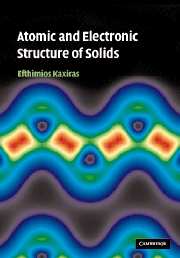Book contents
- Frontmatter
- Contents
- Preface
- Acknowledgments
- I Crystalline solids
- II Defects, non-crystalline solids and finite structures
- III Appendices
- Appendix A Elements of classical electrodynamics
- Appendix B Elements of quantum mechanics
- Appendix C Elements of thermodynamics
- Appendix D Elements of statistical mechanics
- Appendix E Elements of elasticity theory
- Appendix F The Madelung energy
- Appendix G Mathematical tools
- Appendix H Nobel prize citations
- Appendix I Units and symbols
- References
- Index
Appendix E - Elements of elasticity theory
Published online by Cambridge University Press: 06 July 2010
- Frontmatter
- Contents
- Preface
- Acknowledgments
- I Crystalline solids
- II Defects, non-crystalline solids and finite structures
- III Appendices
- Appendix A Elements of classical electrodynamics
- Appendix B Elements of quantum mechanics
- Appendix C Elements of thermodynamics
- Appendix D Elements of statistical mechanics
- Appendix E Elements of elasticity theory
- Appendix F The Madelung energy
- Appendix G Mathematical tools
- Appendix H Nobel prize citations
- Appendix I Units and symbols
- References
- Index
Summary
Elasticity theory considers solids from a macroscopic point of view, and deals with them as an elastic continuum. The basic assumption is that a solid can be divided into small elements, each of which is considered to be of macroscopic size, that is, very large on the atomic scale. Moreover, it is also assumed that we are dealing with small changes in the state of the solid with respect to a reference configuration, so that the response of the solid is well within the elastic regime; in other words, the amount of deformation is proportional to the applied force, just as in a spring. Although these assumptions may seem very restrictive, limiting the applicability of elasticity theory to very large scales, in most cases this theory is essentially correct all the way down to scales of order a few atomic distances. This is due to the fact that it takes a lot of energy to distort solids far from their equilibrium reference state, and for small deviations from that state solids behave in a similar way to elastic springs.
The strain tensor
We begin with the definitions of the strain and stress tensors in a solid. The reference configuration is usually taken to be the equilibrium structure of the solid, on which there are no external forces. We define strain as the amount by which a small element of the solid is distorted with respect to the reference configuration.
- Type
- Chapter
- Information
- Atomic and Electronic Structure of Solids , pp. 622 - 637Publisher: Cambridge University PressPrint publication year: 2003

